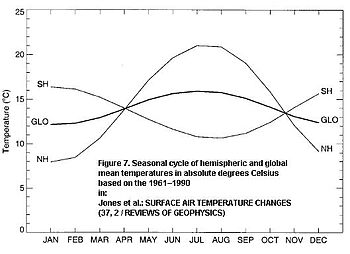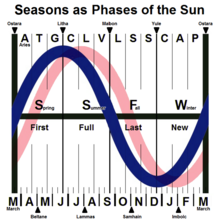Season
Definition
A season is a division of the year marked by changes in weather, ecology, and amount of daylight. On Earth, seasons result from Earth's orbit around the Sun and Earth's axial tilt relative to the ecliptic plane. In temperate and polar regions, the seasons are marked by changes in the intensity of sunlight that reaches the Earth's surface, variations of which may cause animals to undergo hibernation or to migrate, and plants to be dormant.
During May, June, and July, the Northern Hemisphere is exposed to more direct sunlight because the hemisphere faces the Sun. The same is true of the Southern Hemisphere in November, December, and January. It is Earth's axial tilt that causes the Sun to be higher in the sky during the summer months, which increases the solar flux. However, due to seasonal lag, June, July, and August are the warmest months in the Northern Hemisphere while December, January, and February are the warmest months in the Southern Hemisphere.
In temperate and subpolar regions, four calendar-based seasons are generally recognized: spring, summer, autumn or fall, and winter. Ecologists often use a six-season model for temperate climate regions: prevernal, vernal, estival, serotinal, autumnal, and hibernal. Many tropical regions have two seasons: the rainy, wet, or monsoon season and the dry season. Some have a third cool, mild, or harmattan season. Seasons often held special significance for agrarian societies, whose lives revolved around planting and harvest times, and the change of seasons was often attended by ritual.
In some parts of the world, some other "seasons" capture the timing of important ecological events such as hurricane season, tornado season, and wildfire season. The most historically important of these are the three seasons—flood, growth, and low water—which were previously defined by the former annual flooding of the Nile in Egypt.
Causes and effects
Axial tilt
The seasons result from the Earth's axis of rotation being tilted with respect to its orbital plane by an angle of approximately 23.5 degrees.(This tilt is also known as "obliquity of the ecliptic".)
[2]
Regardless of the time of year, the northern and southern hemispheres always experience opposite seasons. This is because during summer or winter, one part of the planet is more directly exposed to the rays of the Sun (see Fig. 1) than the other, and this exposure alternates as the Earth revolves in its orbit. For approximately half of the year (from around March 20 to around September 22), the Northern Hemisphere tips toward the Sun, with the maximum amount occurring on about June 21. For the other half of the year, the same happens, but in the Southern Hemisphere instead of the Northern, with the maximum around December 21. The two instants when the Sun is directly overhead at the Equator are the equinoxes. Also at that moment, both the North Pole and the South Pole of the Earth are just on the terminator, and hence day and night are equally divided between the two hemispheres. Around the March equinox, the Northern Hemisphere will be experiencing springas the hours of daylight increase, and the Southern Hemisphere is experiencing autumn as daylight hours shorten.
The effect of axial tilt is observable as the change in day length and altitude of the Sun at solar noon (the Sun's culmination) during the year. The low angle of Sun during the winter months means that incoming rays of solar radiation are spread over a larger area of the Earth's surface, so the light received is more indirect and of lower intensity. Between this effect and the shorter daylight hours, the axial tilt of the Earth accounts for most of the seasonal variation in climate in both hemispheres.
 Illumination of Earth by Sun at the northern solstice.
Illumination of Earth by Sun at the northern solstice. Illumination of Earth by Sun at the southern solstice.
Illumination of Earth by Sun at the southern solstice. Diagram of the Earth's seasons as seen from the north. Far right: southern solstice
Diagram of the Earth's seasons as seen from the north. Far right: southern solstice Diagram of the Earth's seasons as seen from the south. Far left: northern solstice
Diagram of the Earth's seasons as seen from the south. Far left: northern solstice
Animation of Earth as seen daily from the Sun looking at UTC+02:00, showing the solstice and changing seasons. Two images showing the amount of reflected sunlight at southern and northern summer solstices respectively (watts / m²).
Two images showing the amount of reflected sunlight at southern and northern summer solstices respectively (watts / m²).
Elliptical Earth orbit
Compared to axial tilt, other factors contribute little to seasonal temperature changes. The seasons are not the result of the variation in Earth's distance to the Sun because of its elliptical orbit. In fact, Earth reaches perihelion (the point in its orbit closest to the Sun) in January, and it reaches aphelion (the point farthest from the Sun) in July, so the slight contribution of orbital eccentricity opposes the temperature trends of the seasons in the Northern Hemisphere. In general, the effect of orbital eccentricity on Earth's seasons is a 7% variation in sunlight received.
Orbital eccentricity can influence temperatures, but on Earth, this effect is small and is more than counteracted by other factors; research shows that the Earth as a whole is actually slightly warmer when farther from the sun. This is because the Northern Hemisphere has more land than the Southern, and land warms more readily than sea. Any noticeable intensification of southern winters and summers due to Earth's elliptical orbit is mitigated by the abundance of water in the Southern Hemisphere.
Maritime and hemispheric
Seasonal weather fluctuations (changes) also depend on factors such as proximity to oceans or other large bodies of water, currents in those oceans, El Niño/ENSO and other oceanic cycles, and prevailing winds.
In the temperate and polar regions, seasons are marked by changes in the amount of sunlight, which in turn often causes cycles of dormancy in plants and hibernation in animals. These effects vary with latitude and with proximity to bodies of water. For example, the South Pole is in the middle of the continent of Antarctica and therefore a considerable distance from the moderating influence of the southern oceans. The North Pole is in the Arctic Ocean, and thus its temperature extremes are buffered by the water. The result is that the South Pole is consistently colder during the southern winter than the North Pole during the northern winter.
The seasonal cycle in the polar and temperate zones of one hemisphere is opposite to that of the other. When it is summer in the Northern Hemisphere, it is winter in the Southern, and vice versa.
Tropics
The tropical and subtropical regions see little annual fluctuation of sunlight. However, seasonal shifts occur along a rainy, low-pressure belt called the Intertropical Convergence Zone (ICZ). As a result, the amount of precipitation tends to vary more dramatically than the average temperature. When the Zone is north of the Equator, the northern tropics experience their wet season while the southern tropics have their dry season. This pattern reverses when the Zone migrates to a position south of the Equator.
Mid-latitude thermal lag
In meteorological terms, the solstices (the maximum and minimum insolation) do not fall in the middles of summer and winter. The heights of these seasons occur up to 7 weeks later because of seasonal lag. Seasons, though, are not always defined in meteorological terms.
In astronomical reckoning by hours of daylight alone, the solstices and equinoxes are in the middle of the respective seasons. Because of seasonal lag due to thermal absorption and release by the oceans, regions with a continental climate, which predominate in the Northern Hemisphere, often consider these four dates to be the start of the seasons as in the diagram, with the cross-quarter days considered seasonal midpoints. The length of these seasons is not uniform because of Earth's elliptical orbit and its different speeds along that orbit.
Four-season calendar reckoning
Calendar-based reckoning defines the seasons in absolute rather than relative terms. Accordingly, if floral activity is regularly observed during the coolest quarter of the year in a particular area, it is still considered winter despite the traditional association of flowers with spring and summer. Additionally, the seasons are considered to change on the same dates everywhere that uses a particular calendar method regardless of variations in climate from one area to another. Most calendar-based methods use a four-season model to identify the warmest and coldest seasons, which are separated by two intermediate seasons.
Meteorological
Meteorological seasons are reckoned by temperature, with summer being the hottest quarter of the year and winter the coldest quarter of the year. In 1780 the Societas Meteorologica Palatina (which became defunct in 1795), an early international organization for meteorology, defined seasons as groupings of three whole months as identified by the Gregorian calendar. Ever since, professional meteorologists all over the world have used this definition. Therefore, for temperate areas in the northern hemisphere, spring begins on 1 March, summer on 1 June, autumn on 1 September, and winter on 1 December. For the southern hemisphere temperate zone, spring begins on 1 September, summer on 1 December, autumn on 1 March, and winter on 1 June. In Australasia the meteorological terms for seasons apply to the temperate zone that occupies all of New Zealand, New South Wales, Victoria, Tasmania, the south-eastern corner of South Australia and the south-west of Western Australia, and the south east Queensland areas south of Brisbane.
| Season | Start date | End date |
|---|---|---|
| Summer | 1 December | 28 February |
| Autumn | 1 March | 31 May |
| Winter | 1 June | 31 August |
| Spring | 1 September | 30 November |
In Sweden and Finland, meteorologists use a non-calendar based definition for the seasons based on the temperature. Spring begins when the daily averaged temperature permanently rises above 0 °C, summer begins when the temperature permanently rises above +10 °C, summer ends when the temperature permanently falls below +10 °C and winter begins when the temperature permanently falls below 0 °C. "Permanently" here means that the daily averaged temperature has remained above or below the limit for seven consecutive days. This implies two things: first, the seasons do not begin at fixed dates but must be determined by observation and are known only after the fact; and second, a new season begins at different dates in different parts of the country. In Great Britain, the onset of spring used to be defined as when the maximum daily temperature reached 50 °F (10 °C) in a defined sequence of days. This almost always occurred in March. However, with global warming this temperature is now not uncommon in the winter.
| Surface air temperature | |
|---|---|
Astronomical
| event | equinox | solstice | equinox | solstice | ||||
|---|---|---|---|---|---|---|---|---|
| month | March | June | September | December | ||||
| year | ||||||||
| day | time | day | time | day | time | day | time | |
| 2010 | 20 | 17:32 | 21 | 11:28 | 23 | 03:09 | 21 | 23:38 |
| 2011 | 20 | 23:21 | 21 | 17:16 | 23 | 09:04 | 22 | 05:30 |
| 2012 | 20 | 05:14 | 20 | 23:09 | 22 | 14:49 | 21 | 11:12 |
| 2013 | 20 | 11:02 | 21 | 05:04 | 22 | 20:44 | 21 | 17:11 |
| 2014 | 20 | 16:57 | 21 | 10:51 | 23 | 02:29 | 21 | 23:03 |
| 2015 | 20 | 22:45 | 21 | 16:38 | 23 | 08:21 | 22 | 04:48 |
| 2016 | 20 | 04:30 | 20 | 22:34 | 22 | 14:21 | 21 | 10:44 |
| 2017 | 20 | 10:28 | 21 | 04:24 | 22 | 20:02 | 21 | 16:28 |
| 2018 | 20 | 16:15 | 21 | 10:07 | 23 | 01:54 | 21 | 22:23 |
| 2019 | 20 | 21:58 | 21 | 15:54 | 23 | 07:50 | 22 | 04:19 |
| 2020 | 20 | 03:50 | 20 | 21:44 | 22 | 13:31 | 21 | 10:02 |
Astronomical timing as the basis for designating the temperate seasons dates back at least to the Julian calendar used by the ancient Romans. It continues to be used on many modern Gregorian calendars worldwide, although some countries like Australia, New Zealand, and Russia prefer to use meteorological reckoning. The precise timing of the seasons is determined by the exact times of transit of the sun over the tropics of Cancer and Capricorn for the solstices and the times of the sun's transit over the equator for the equinoxes, or a traditional date close to these times.
The following diagram shows the relation between the line of solstice and the line of apsides of Earth's elliptical orbit. The orbital ellipse (with eccentricity exaggerated for effect) goes through each of the six Earth images, which are sequentially the perihelion (periapsis—nearest point to the sun) on anywhere from 2 January to 5 January, the point of March equinox on 19, 20 or 21 March, the point of June solstice on 20 or 21 June, the aphelion (apoapsis—farthest point from the sun) on anywhere from 4 July to 7 July, the September equinox on 22 or 23 September, and the December solstice on 21 or 22 December.
These "astronomical" seasons are not of equal length, because of the elliptical nature of the orbit of the Earth, as discovered by Johannes Kepler. From the March equinox it currently takes 92.75 days until the June solstice, then 93.65 days until the September equinox, 89.85 days until the December solstice and finally 88.99 days until the March equinox.
Variation due to calendar misalignment
The times of the equinoxes and solstices are not fixed with respect to the modern Gregorian calendar, but fall about six hours later every year, amounting to one full day in four years. They are reset by the occurrence of a leap year. The Gregorian calendar is designed to keep the March equinox no later than 21 March as accurately as is practical. Also see: Gregorian calendar seasonal error.
The calendar equinox (used in the calculation of Easter) is 21 March, the same date as in the Easter tables current at the time of the Council of Nicaea in AD 325. The calendar is therefore framed to prevent the astronomical equinox wandering onto 22 March. From Nicaea to the date of the reform, the years 500, 600, 700, 900, 1000, 1100, 1300, 1400 and 1500, which would not have been leap years in the Gregorian calendar, amount to nine days, but astronomers directed that ten days be removed.
Currently, the most common equinox and solstice dates are March 20, June 21, September 22 or 23 and December 21; the four-year average slowly shifts to earlier times as the century progresses. This shift is a full day in about 128 years (compensated mainly by the century "leap year" rules of the Gregorian calendar) and as 2000 was a leap year the current shift has been progressing since the beginning of the last century, when equinoxes and solstices were relatively late. This also means that in many years of the twentieth century, the dates of March 21, June 22, September 23 and December 22 were much more common, so older books teach (and older people may still remember) these dates.
Note that all the times are given in UTC (roughly speaking, the time at Greenwich, ignoring British Summer Time). People living farther to the east (Asia and Australia), whose local times are in advance, will see the astronomical seasons apparently start later; for example, in Tonga (UTC+13), an equinox occurred on September 24, 1999, a date which will not crop up again until 2103. On the other hand, people living far to the west (America) whose clocks run behind UTC may experience an equinox as early as March 19.
Change over time
Over thousands of years, the Earth's axial tilt and orbital eccentricity vary (see Milankovitch cycles). The equinoxes and solstices move westward relative to the stars while the perihelion and aphelion move eastward. Thus, ten thousand years from now Earth's northern winter will occur at aphelion and northern summer at perihelion. The severity of seasonal change — the average temperature difference between summer and winter in location — will also change over time because the Earth's axial tilt fluctuates between 22.1 and 24.5 degrees.
Smaller irregularities in the times are caused by perturbations of the Moon and the other planets.
Solar
Solar timing is based on insolation in which the solstices and equinoxes are seen as the midpoints of the seasons. It was the method for reckoning seasons in medieval Europe, especially by the Celts, and is still ceremonially observed in Ireland and some east Asian countries. Summer is defined as the quarter of the year with the greatest insolation and winter as the quarter with the least.
The solar seasons change at the cross-quarter days, which are about 3–4 weeks earlier than the meteorological seasons and 6–7 weeks earlier than seasons starting at equinoxes and solstices. Thus, the day of greatest insolation is designated "midsummer" as noted in William Shakespeare's play A Midsummer Night's Dream, which is set on the summer solstice. On the Celtic calendar, the start of the seasons corresponds to four Pagan agricultural festivals - the traditional first day of winter is 1 November (Samhain, the Celtic origin of Halloween); spring starts 1 February (Imbolc, the Celtic origin of Groundhog Day); summer begins 1 May (Beltane, the Celtic origin of May Day); the first day of autumn is 1 August (Celtic Lughnasadh).
The traditional calendar in China forms the basis of other such systems in East Asia. Its seasons are traditionally based on 24 periods known as solar terms. The four seasons chūn (春), xià (夏), qiū (秋), and dōng (冬) are universally translated as "spring", "summer", "autumn", and "winter" but actually begin much earlier, with the solstices and equinoxes forming the midpoint of each season rather than their start. Astronomically, the seasons are said to begin on Lichun (立春, lit. "standing spring") on about 4 February, Lixia (立夏) on about 6 May, Liqiu (立秋) on about 8 August, and Lidong (立冬) on about 7 November. These dates were not part of the traditional lunar calendar, however, and moveable holidays such as Chinese New Year and the Mid-Autumn Festival are more closely associated with the seasons.
Six-season calendar reckoning
Some calendars in south Asia use a six-season method where the number of seasons between summer and winter can number from one to three. The dates are fixed at even intervals of months.
In the Hindu calendar of tropical and subtropical India, there are six seasons or Ritu that are calendar-based in the sense of having fixed dates: Vasanta (spring), Greeshma (summer), Varsha(monsoon), Sharad (autumn), Hemanta (early winter), and Shishira (prevernal or late winter). The six seasons are ascribed to two months each of the twelve months in the Hindu calendar. The rough correspondences are:
| Hindu season | Start | End | Hindu Months | Mapping to English Names |
|---|---|---|---|---|
| Vasanta | Mid-March | Mid-May | Chaitra, Vaishakha | spring |
| Greeshma | Mid-May | Mid-July | Jyeshtha, Ashadha | summer |
| Varsha | Mid-July | Mid-September | Shraavana, Bhadrapada | monsoon |
| Sharad | Mid-September | Mid-November | Ashwin, Kartika | autumn |
| Hemanta | Mid-November | Mid-January | Maargashirsha, Pausha | early winter |
| Shishira | Mid-January | Mid-March | Magh, Phalguna | prevernal or late winter |
The Bengali Calendar is similar but differs in start and end times. It has the following seasons or ritu:
| Bengali season | Start | End | Bengali Months | Mapping to English Names |
|---|---|---|---|---|
| Bosonto বসন্ত (ঋতু) (Spring) | Mid-February | Mid-April | Falgun, Choitro | Spring |
| Grishmo (গ্রীষ্ম) (Summer) | Mid-April | Mid-June | Boishakh, Joishtho | Summer |
| Borsha (বর্ষা) (Monsoon) | Mid-June | Mid-August | Asharh, Srabon | Monsoon |
| Shorot (শরৎ) (Autumn/ Fall) | Mid-August | Mid-October | Bhadro, Ashwin | Autumn |
| Hemonto (হেমন্ত) (Frost/ Late Autumn) | Mid-October | Mid-December | Kartik, Ogrohayon | Late Autumn |
| Sit (শীত) (Winter) | Mid-December | Mid-February | Poush, Magh | Winter |
The Tamil calendar follows a similar pattern of six seasons
| Tamil season | Gregorian Months | Tamil Months |
|---|---|---|
| IlaVenil (Spring) | April 15 to June 14 | Chithirai and Vaikasi |
| MuthuVenil (Summer) | June 15 to August 14 | Aani and Aadi |
| Kaar (Monsoon) | August 15 to October 14 | Avani and Purattasi |
| Kulir (Autumn) | October 15 to December 14 | Aipasi and Karthikai |
| MunPani (Winter) | December 15 to February 14 | Margazhi and Thai |
| PinPani (Prevernal) | February 15 to April 14 | Maasi and Panguni |
Polar day and night
Any point north of the Arctic Circle or south of the Antarctic Circle will have one period in the summer when the sun does not set, and one period in the winter when the sun does not rise. At progressively higher latitudes, the maximum periods of "midnight sun" and "polar night" are progressively longer.
For example, at the military and weather station Alert located at 82°30′05″N and 62°20′20″W, on the northern tip of Ellesmere Island, Canada (about 450 nautical miles or 830 km from the North Pole), the sun begins to peek above the horizon for minutes per day at the end of February and each day it climbs higher and stays up longer; by 21 March, the sun is up for over 12 hours. On 6 April the sun rises at 0522 UTC and remains above the horizon until it sets below the horizon again on 6 September at 0335 UTC. By October 13 the sun is above the horizon for only 1 hour 30 minutes and on October 14 it does not rise above the horizon at all and remains below the horizon until it rises again on 27 February.
First light comes in late January because the sky has twilight, being a glow on the horizon, for increasing hours each day, for more than a month before the sun first appears with its disc above the horizon. From mid-November to mid-January, there is no twilight.
In the weeks surrounding 21 June, in the northern polar region, the sun is at its highest elevation, appearing to circle the sky there without going below the horizon. Eventually, it does go below the horizon, for progressively longer periods each day until around the middle of October, when it disappears for the last time until the following February. For a few more weeks, "day" is marked by decreasing periods of twilight. Eventually, from mid-November to mid-January, there is no twilight and it is continuously dark. In mid January the first faint wash of twilight briefly touches the horizon (for just minutes per day), and then twilight increases in duration with increasing brightness each day until sunrise at end of February, then on 6 April the sun remains above the horizon until mid October.
Non-calendar-based reckoning
Ecologically speaking, a season is a period of the year in which only certain types of floral and animal events happen (e.g.: flowers bloom—spring; hedgehogs hibernate—winter). So, if we can observe a change in daily floral/animal events, the season is changing. In this sense, ecological seasons are defined in absolute terms, unlike calendar-based methods in which the seasons are relative. If specific conditions associated with a particular ecological season don't normally occur in a particular region, then that area cannot be said to experience that season on a regular basis.
Modern mid-latitude ecological
Six seasons can be distinguished which do not have fixed calendar-based dates like the meteorological and astronomical seasons. Oceanic regions tend to experience the beginning of the hibernal season up to a month later than continental climates. Conversely, prevernal and vernal seasons begin up to a month earlier near oceanic and coastal areas. For example, prevernal crocus blooms typically appear as early as February in coastal areas of British Columbia, the British Isles, but generally don't appear until March or April in locations like the Midwest USA or parts of eastern Europe. The actual dates for each season vary by climate region and can shift from one year to the next. Average dates listed here are for mild and cool temperate climate zones in the Northern Hemisphere:
- Prevernal (early or pre-spring): Begins February (mild temperate), to March (cool temperate). Deciduous tree buds begin to swell. Some types of migrating birds fly from winter to summer habitats.
- Vernal (spring): Begins mid March (mild temperate), to late April (cool temperate). Tree buds burst into leaves. Birds establish territories and begin mating and nesting.
- Estival (high summer): Begins June in most temperate climates. Trees in full leaf. Birds hatch and raise offspring.
- Serotinal (late summer): Generally begins mid to late August. Deciduous leaves begin to change color in higher latitude locations (above 45 north). Young birds reach maturity and join other adult birds preparing for autumn migration. The traditional "harvest season" begins by early September.
- Autumnal (autumn): Generally begins mid to late September. Tree leaves in full color then turn brown and fall to the ground. Birds migrate back to wintering areas.
- Hibernal (winter): Begins December (mild temperate), November (cool temperate). Deciduous trees are bare and fallen leaves begin to decay. Migrating birds settled in winter habitats.
Tropical ecological
In the tropics, where seasonal dates also vary, it is more common to speak of the rainy (or wet, or monsoon) season versus the dry season. For example, in Nicaragua the dry season (November to April) is called 'summer' and the rainy season (May to October) is called 'winter', even though it is located in the northern hemisphere. In some tropical areas a three-way division into hot, rainy, and cool season is used. There is no noticeable change in the amount of sunlight at different times of the year. However, many regions (such as the northern Indian ocean) are subject to monsoon rain and wind cycles.
Floral and animal activity variation near the equator depends more on wet/dry cycles than seasonal temperature variations, with different species flowering (or emerging from cocoons) at specific times before, during, or after the monsoon season. Thus, the tropics are characterized by numerous "mini-seasons" within the larger seasonal blocks of time.
In the tropical parts of Australia in the northern parts of Queensland, Western Australia and the Northern Territory, wet and dry seasons are observed in addition to or in place of temperate season names.
Indigenous ecological
Indigenous people in polar, temperate and tropical climates of northern Eurasia, the Americas, Africa, Oceania, and Australia have traditionally defined the seasons ecologically by observing the activity of the plants, animals and weather around them. Each separate tribal group traditionally observes different seasons determined according to local criteria that can vary from the hibernation of polar bears on the arctic tundras to the growing seasons of plants in the tropical rainforests. In Australia, some tribes have up to eight seasons in a year, as do the Sami people in Scandinavia. Many indigenous people who no longer live directly off the land in traditional often nomadic styles, now observe modern methods of seasonal reckoning according to what is customary in their particular country or region.
"Official" designations
As noted, a variety of dates are used in different countries to mark the changes of seasons, especially those that are calendar based. These observances are often declared "official" within their respective jurisdictions by the local or national media, even when the weather or climate is contradictory. However they are mainly a matter of custom only, and have not generally been proclaimed by governments north or south of the equator for civil purposes.












